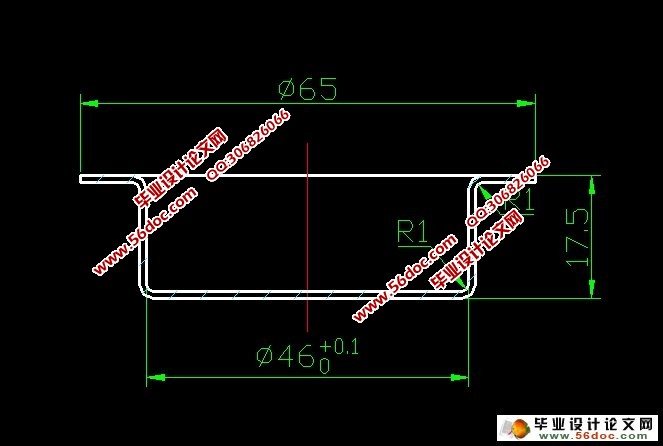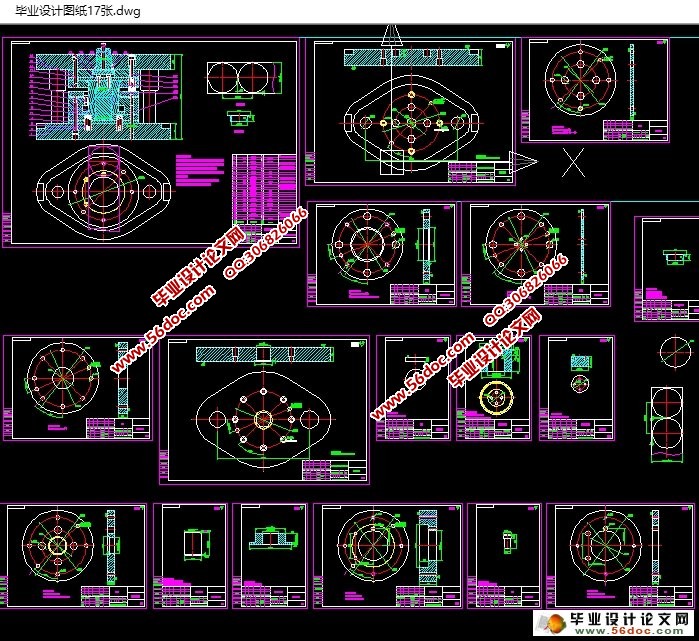下端盖落料拉伸模毕业设计(含CAD零件图装配图)
来源:wenku163.com 资料编号:WK16310826 资料等级:★★★★★ %E8%B5%84%E6%96%99%E7%BC%96%E5%8F%B7%EF%BC%9AWK16310826
资料介绍
下端盖落料拉伸模毕业设计(含CAD零件图装配图)(开题报告,文献综述,设计说明书10000字,CAD图17张)
摘 要
对于本次毕业设计是根据下端盖产品图来进行冲压模具设计的。对冲件图样进行有效合理分析,分析冲压件工艺过程中设计的可行性方案,选择并确定最佳方案;具体计算和设计该方案中各工序的工艺参数,计算展开料尺寸及拉深系数、拉深次数,计算压力及选择冲压设备;模具总体结构设计:设计零件和装配之间的关系,模具结构上一系列形式,模具零件结构尺寸设计:设计我们冲压过程中所需要的凸模、凹模、卸料、导向等工作零件,选择我们需要的模板型号;并采用相关计算机软件所绘制的一系列模具零件图、装配图。在现代社会中模具生产效率越来越高,各材料以及成本都得到了大大的降低,各行业模具厂在技术运用方面更加完善,在我国各行各业都得到了很广泛的运用,并且在模具的寿命,表面质量和精度等都提出了行更高的要求,在冲压和模具设计中,也带给了我们生活中很多方便,已经在我们的生活中都能够得到运用和体现,而且实用性极强。
关键词:工艺参数、冲压工序、冲压件、工艺分、冲压模具
ABSTRACT
This graduation design is according to the diagram to lower cover product stamping mould design. Hedge design reasonable analysis, analysis of stamping process design the feasibility of the scheme, choose and determine the best solutions; Detailed calculation and design the scheme of the process parameters of each process, the size of computation and drawing coefficient, drawing number, calculate stress and choose stamping equipment; Overall structure design: design the mould structure form, assembly relationship, select parts material and the heat treatment requirements; Mould parts structure size design: design of stamping process we need punch,concave die, the working parts of the discharging, orientation, etc, choose we need template model; And using computer software to draw the mold assembly drawing and part drawing.
Key words: process parameters;stamping parts; stamping process ;stamping tool; process analysis





目 录
第一章 绪论 1
1.1.课题来源及意义 1
1.2.冲压及模具 1
1.3.设计的目的 1
第二章 冲裁件的工艺性分析 3
2.1.冲压件的结构工艺性 3
2.1.1.冲压件的形状 3
2.1.2.零件的工艺性分析 3
2.1.3.冲裁件的尺寸精度 4
第三章 制件冲压工艺方案的确定 5
3.1.冲压工序的组合与选择 5
第四章 制件排样图的设计及材料利用率的计算 6
4.1.展开尺寸的计算 6
4.2.制件排样图的设计 7
4.2.1.搭边与料宽 8
4.3.材料利用率的计算 9
第五章 确定总冲压力和选用压力机及计算压力中心 10
5.1.落料拉伸模 10
5.2.压力中心的计算 11
5.3.压力机的选用 12
第六章 凸、凹模刃口尺寸计算 14
6.1.拉伸模 14
第七章 模具整体结构形式设计 17
7.1.落料拉伸模结构形式: 17
第八章 模具零件的结构设计 18
8.1.拉伸凸模的设计 18
8.2.凸凹模的设计 18
8.3.落料凹模的设计 19
8.4.凸凹模固定板的设计 20
第九章 压力机的校核 23
9.1.压力机的校核 23
第十章 模具的总装配 24
设计小结 25
致 谢 27
参考文献 28
|











